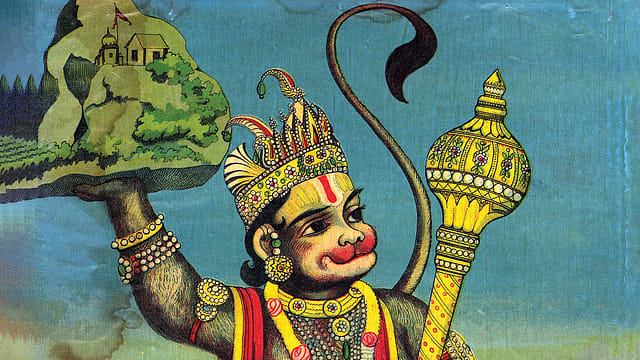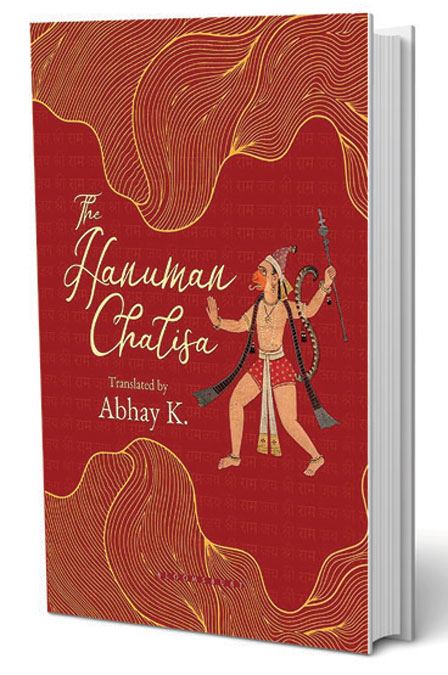Updating Hanuman


THE HANUMAN CHALISA is one of the most popular and powerful devotional hymns dedicated to Lord Hanuman. It was composed by Goswami Tulsidas (1511-1623) in the Awadhi language around 1575.
The Bhakti movement was at its peak in North and East India between the 15th and 17th centuries. It emphasised direct, personal devotion to a chosen deity, with the aim of attaining liberation through love and surrender. Tulsidas primarily followed Saguna Bhakti, focusing on the divine attributes of Lord Rama, inspiring personal devotion.
He viewed Hanuman as the epitome of a devotee (bhakta). Hanuman’s selfless service, unwavering loyalty, and strength in the face of adversity made him a powerful symbol of bhakti in Tulsidas’ eyes. So he accepted Hanuman as his role model and guru, who could lead him to Lord Rama and help him attain spiritual liberation.
The Hanuman Chalisa consists of two opening dohas praising the guru and seeking Hanuman’s blessings, forty chaupais and a closing doha for Hanuman’s grace and protection. It is recited by millions of devotees for strength, protection and blessings.
Goswami Tulsidas was the pen name of Rambola Dubey. As per legend, he was named Rambola because the first words he spoke after his birth were “Rama, Rama!” Orphaned soon after, he was accepted as a disciple by Narharidas of the Ramananda order and was named Tulsidas. He became famous after composing the Ramcharitmanas, which he wrote in Awadhi to make the story of Rama more accessible to those who did not know Sanskrit.
Lost: The Unstoppable Decline of Congress
05 Dec 2025 - Vol 04 | Issue 50
Serial defeats | Leadership in denial | Power struggles
Hanuman was born to Anjana and Kesari at the Anjanadri Hill in Tirumala. Anjaneri in Nashik, Maharashtra, and Anjeneri and Anjanadri (near Hampi) in Gangavathi Taluk, Koppal District, Karnataka, are places that claim to be the location of Kishkindha, where Hanuman spent his childhood.
The Shiva Purana mentions Hanuman as an avatar of Shiva; all other puranas and scripture clearly refer to him as the spiritual son of Vayu or an incarnation of Vayu. The Skanda Purana, a South Indian version of the Shiva Purana, presents Hanuman as the union of Shiva and Vishnu, or as Ayyappa, the son of Shiva and Mohini (the female avatar of Vishnu). The 17th-century Odia work Rasavinoda by Dinakrishnadasa mentions that the three gods—Brahma, Vishnu, and Shiva—came together to take the form of Hanuman.
‘Hanuman’ means one who has a disfigured jaw. According to a puranic legend, the infant Hanuman mistakes the sun for a fruit and heroically attempts to reach it. To protect the sun from him, Indra, the king of gods, hurls his thunderbolt at Hanuman, wounding him in the jaw.
Reading or chanting the Hanuman Chalisa regularly invokes Hanuman’s blessings, grants courage, strength, wisdom and devotion, and removes fear and negative energy, protecting one from evil, wicked influences and afflictions.
The hymn’s impact transcends religious ritual—it is a source of inspiration and motivation for millions.
The Hanuman Chalisa is an invaluable guide for navigating the modern world with strength and clarity. Wherever chanted, its verses continue to uplift, protect and empower. The Chalisa glorifies Hanuman as the ideal bhakta, embodying humility, strength, and complete surrender. Hanuman is a spiritual master who connects the jiva (soul) to Rama (supreme reality).
Though a Rudra avatar (a form of Shiva), Hanuman is Rama’s devotee, unifying the followers of Shaivism and Vaishnavism. Hanuman’s presence across all yugas emphasises the eternal power of devotion. As the son of Vayu (the wind god), he represents life-force energy (prana), critical to yoga and inner vitality.
Despite being over four centuries old, the Hanuman Chalisa continues to resonate deeply in our world, far beyond its original cultural and historical context. Its verses, rich in metaphor and spiritual symbolism, offer guidance, reassurance and empowerment in today’s complex, fast-paced life.
In an age marked by stress, anxiety and psychological challenges, the Hanuman Chalisa provides a sense of mental fortitude. Chanting or even silently reading the hymn can have a calming, meditative effect. The invocation of Hanuman’s indomitable courage and unwavering focus serves as an emotional anchor when facing personal or professional challenges.
The Hanuman Chalisa is a powerful tool for mindfulness. When recited, its structured metre, repetition and sacred sound vibrations help still the mind, much like a mantra or breathwork practice. It draws practitioners into the present moment, enhancing concentration and inner awareness.
In an era when narcissism and ambition often overshadow community spirit and compassion, Hanuman stands as a timeless ideal of humility and devotion. His service to Lord Rama, without the expectation of reward, reminds us of the power of serving a higher purpose. It is especially relevant for healthcare and public service professionals.
Many turn to the Chalisa in moments of self-doubt or fear. Hanuman, who forgot his own divine powers until reminded of them, is a role model in a world where self-doubt is common. The Chalisa reminds us that strength lies within, waiting to be awakened through self-belief and spiritual awareness.
While rooted in Hindu tradition, the Hanuman Chalisa is now recited and appreciated across the world by people of various backgrounds. Its themes of courage, faith and resilience are universal. It has been translated into multiple languages, set to music across genres and used in everything from yoga classes to motivational speeches. Former US President Barack Obama carried an image of a Thai Hanuman in his pocket.
The story of Hanuman travelled along with Indians wherever they went, particularly to Southeast Asia. Hanuman is known as Anuman in Thailand and Andoman in Malaysia. Malay sailors and traders pronounced Hanuman as Handuman, which gradually became Andaman over centuries. In Chinese literature, Hanuman is known as Sun Wukong, an incredible white monkey with miraculous powers, who travelled with the Chinese monk Xuanzang to India, protecting him from demons. Many Japanese villages and Shinto temples have a divine monkey (Sarutahiko), who resembles Hanuman, as a protector.
The Bada Mangal festival, during which Hanuman is worshipped every Tuesday from May to June, was started by the nawabs of Lucknow.
I was introduced to the Hanuman Chalisa in my school days and have been reciting it since. I have sought solace in the Chalisa in times of distress and it has helped me immensely. Lately, I came across a number of English translations of the Hanuman Chalisa which inspired me to do my own lyrical and singable translation while retaining the energy, flow and rhythm of the original Awadhi text by Tulsidas. I hope my rendering of the Hanuman Chalisa helps readers across the globe access its immense power and positivity.
